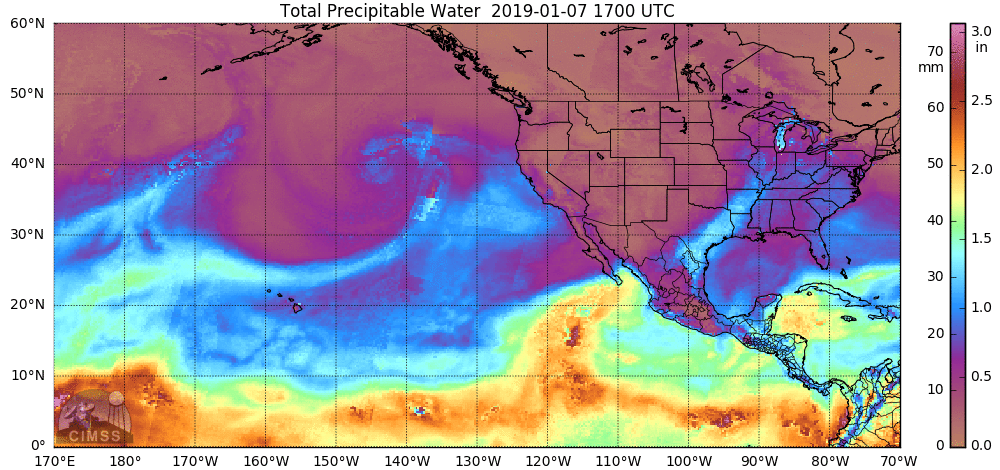How do they happen?
Atmospheric rivers commonly begin as warm water storms over the Pacific Ocean, where evaporation creates a high concentration of moisture in the air. Prevailing winds give ARs their distinctive shape, and probably helped give rise to their comparisons to a fire hose, pointed at California.
When ARs are blown over land, the giant streams of moisture they contain cool and condense, causing heavy snow or downpours, depending on the elevation.
The term “Pineapple Express” (not this Pineapple Express) refers to ARs that form in tropical regions of the Pacific, often around Hawaii. These can pound the west coast of North America from California to Canada with intense storms.
But what makes ARs different from other storms?
Atmospheric rivers are categorized by a unit of measurement called Integrated Water Vapor Transport (IVT). IVT takes into account both the amount of water vapor in the system and the wind that moves it around, making it flow like a, well, giant river in the atmosphere.
For a storm to be classified as an AR, it must reach an IVT threshold of 250 units. An atmospheric river with IVT of 1,000 or more is considered “extreme.” ARs fall into five categories, from “weak” to “exceptional.” Wednesday’s storm is expected to be a Category 3, or “strong,” according to data from CW3E.
Are atmospheric rivers good or bad?
Atmospheric rivers produce up to 50% of California’s precipitation annually and 65% seasonally (PDF). According to Ralph, the state gets one to two dozen AR storms per year. When we have fewer, we get … yes, that would be drought.
“Atmospheric rivers make or break our water year in California,” Ralph says.
However, when we get too much AR storm activity, look out.
A typical atmospheric river event lasts about a day. Problems begin when they last longer in duration or occur back-to-back. This can lead to major hazards like flooding, mudslides or ash flow in the aftermath of wildfires.
Research suggests that atmospheric rivers contributed to the collapse of both spillways at Oroville Dam in February of 2017.
ARs were also undoubtedly behind the worst floods in California’s history, when the state capital of Sacramento was inundated during the winter of 1861–62.
Atmospheric rivers don’t just affect California. Here’s a quick Canadian take on them:
Should I be worried?
Though ARs don’t get assigned names, like hurricanes, they are the “900-pound gorilla” of West Coast weather.
“For the West Coast, they are really our big storms,” says Julie Kalansky, operations manager at CW3E.
The problem in the past has been that atmospheric rivers have been hard to forecast. While satellites provide some information, ARs are relatively low-lying storm systems, which means they’re often obscured from space by higher altitude clouds. Atmospheric rivers fall into five categories, from “weak” to “exceptional.” Wednesday’s storm is expected to be a Category 3, or “strong,” according to data from CW3E.
In recent years, Ralph and his colleagues at the Scripps Institution of Oceanography as well as the Air Force and the National Oceanic and Atmospheric Administration have been working to better understand AR phenomena. They’re using techniques like flying aircraft along the path of atmospheric rivers and dropping weather sensors called “dropsondes” directly into them from above.
How is climate change affecting ARs?
Ralph says there is still more research to be done, but atmospheric rivers are increasingly appearing in climate models. He notes that the recently released National Climate Assessment added ARs to the list of extreme weather threats.
One thing appears to be clear: The warmer the atmosphere, the more moisture an atmospheric river can contain.
Ralph says this may not increase the frequency of atmospheric rivers in the future, but will make them more intense.
“They will be stronger,” Ralph says, “That’s pretty much a consensus in the [scientific] community.”
A version of this story was originally published on Jan. 16, 2019.
KQED’s Senior Science Editor Kevin Stark, Science Editor Craig Miller and Jenny Pritchett contributed to this post.
